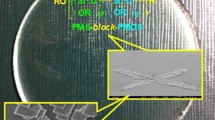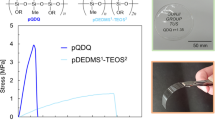Abstract
Water soluble polysiloxanes were prepared by condensation of 3-aminopropyl diethoxymethylsilane followed by the reaction of the amines with ethylene carbonate to yield carbamate side chains with terminal hydroxyl groups attached to each silicon atom in the polymer chain. The molecular weight of these carbinol functional polysiloxanes was controlled by adding known concentrations of hexamethyldisiloxane during the polycondensation reaction. The structure of these polymers was confirmed by 1H NMR and FTIR. The resulting polysiloxanes are water soluble and their solubility is independent of the pH or the molecular weight of the polymer. Furthermore, no additives are needed in the water to enhance the solubility of these polymers. The mechanical properties of films that were cast from water solutions were studied and indicated the presence of strong hydrogen bonds that provide for elastomeric films with no need for additional crosslink agents. The hydrophilic nature of the polymer was further confirmed by contact angle measurements and thermal properties data clearly indicate the presence of bound water associated with the large number of hydroxyl groups in the polymer. SEM images of paper coatings prepared from these polysiloxanes revealed a smooth surface with no apparent structural defects that can be used as an anti-graffiti coating.
Similar content being viewed by others
References
Noll W (ed) (1968) Chemistry and technology of silicones. Academic Press, New York
Barbier V, Tatoulian M, Li H, Arefi-Khonsari F, Ajdari A, Tabeling P (2006) Stable modification of PDMS surface properties by plasma polymerization: application to the formation of double emulsions in microfluidic systems. Langmuir 22(12):5230– 5232
Makamba H, Kim JH, Lim K, Park N, Hahn JH (2003) Surface modification of poly (dimethylsiloxane) microchannels. Electrophoresis 24(21):3607–3619
Trimbach DC, Al-Hussein M, de Jeu WH, Decré M, Broer DJ, Bastiaansen CW (2004) Hydrophilic elastomers for microcontact printing of polar inks. Langmuir 20(11):4738–4742
Wang R, Yang Y-L, Qin M, Wang L-K, Yu L, Shao B, Qiao M-Q, Wang C, Feng X-Z (2007) Biocompatible hydrophilic modifications of poly (dimethylsiloxane) using self-assembled hydrophobins. Chem Mater 19(13):3227–3231
Gao Z, Schulze Nahrup J, Mark JE, Sakr A (2004) Poly (dimethylsiloxane) coatings for controlled drug release. II. Mechanism of the crosslinking reaction in emulsion. J Appl Polym Sci 91(4):2186–2194
Gao Z, Nahrup JS, Mark JE, Sakr A (2005) Poly (dimethylsiloxane) coatings for controlled drug release. III. Drug release profiles and swelling properties of the free-standing films. J Appl Polym Sci 96(2):494–501
Mashak A, Rahimi A (2009) Silicone polymers in controlled drug delivery systems: a review. Iran Polym J 18(4):279–295
Roman GT, Culbertson CT (2006) Surface engineering of poly (dimethylsiloxane) microfluidic devices using transition metal sol-gel chemistry. Langmuir 22(9):4445–4451
Hong SM, Kim SH, Kim JH, Hwang HI Hydrophilic surface modification of PDMS using atmospheric RF plasma. In: Journal of Physics: Conference Series, 2006. vol 1. IOP Publishing, p 656
Efimenko K, Wallace WE, Genzer J (2002) Surface modification of Sylgard-184 poly (dimethyl siloxane) networks by ultraviolet and ultraviolet/ozone treatment. J Colloid Interface Sci 254(2):306–315
Gongjian B, Yunxuan W, Xingzhou H (1996) Surface modification of polyolefine by UV light/ozone treatment. J Appl Polym Sci 60(13):2397–2402
Hillborg H, Gedde U (1998) Hydrophobicity recovery of polydimethylsiloxane after exposure to corona discharges. Polymer 39(10):1991–1998
Lee CF, Hsieh PH, Ghosh SK, Kuo PL (2002) Emulsifying and self-emulsified properties of siloxane polymer grafted with easy hydrophile. J Appl Polym Sci 86(10):2408–2415
Hou S-S, Chung Y-P, Chan C-K, Kuo P-L (2000) Function and performance of silicone copolymer. Part IV. Curing behavior and characterization of epoxy–siloxane copolymers blended with diglycidyl ether of bisphenol-A. Polymer 41(9):3263–3272
Hill RM (1999) Silicone surfactants. Surfactant Science Series. Marcel Dekker, New York
Alexandru M, Cazacu M, Racles C, Grigoras C (2011) Amphiphile polydimethylsiloxane-based networks reinforced with in situ generated silica. Polym Eng Sci 51(1):78–86
Cazacu M, Ioanid A, Ioanid G, Racles C, Vlad A (2006) Amphiphilic sorbents based on polysiloxanes crosslinked by an N, N’-heterocycle. Appl Organomet Chem 20(8):494–498
Iwakiri N, Nishikawa T, Kaneko Y, Kadokawa J-I (2009) Synthesis of amphiphilic polysiloxanes and their properties for formation of nano-aggregates. Colloid Polym Sci 287(5):577–582
Kaneko Y, Iyi N, Kurashima K, Matsumoto T, Fujita T, Kitamura K (2004) Hexagonal-structured polysiloxane material prepared by sol-gel reaction of aminoalkyltrialkoxysilane without using surfactants. Chem Mater 16(18):3417–3423
Kaneko Y, Kadokawa J-i, Setoguchi M, Iyi N (2005) Synthesis of rodlike polysiloxane containing polyol moieties derived from glucose with regularly controlled higher-ordered structure. Polymer 46(21):8905–8907
Tachibana Y, Shi X, Graiver D, Narayan R (2012) Hydroxyl terminated hydrophilic silanes. Silicon 4(3):167–174
Launer PJ (1987) Infrared analysis of organosilicon compounds: spectra-structure correlations. Silicone Compounds Register and Review: 100–103
Jayasekara R, Harding I, Bowater I, Christie G, Lonergan G (2004) Preparation, surface modification and characterisation of solution cast starch PVA blended films. Polym Test 23(1):17–27
Hassan CM, Peppas NA (2000) Structure and applications of poly (vinyl alcohol) hydrogels produced by conventional crosslinking or by freezing/thawing methods. In: Biopolymers. PVA Hydrogels, Anionic Polymerisation Nanocomposites. Springer, pp 37–65
Goswami BC, Anandjiwala RD, Hall D (eds) (2004) Textile Sizing, Chapter 3.4 “Polyvinyl Alcohol”. Marcel Dekker, New York
Hassan CM, Peppas NA (2000) Structure and Morphology of Freeze/Thawed PVA Hydrogels. Macromolecules 33(7):2472–2479
Holland B, Hay J (2001) The thermal degradation of poly (vinyl alcohol). Polymer 42(16):6775–6783
Guirguis OW, Moselhey MT (2011) Thermal and structural studies of poly (vinyl alcohol) and hydroxypropyl cellulose blends. Nat Sci 4(1):57–67
Author information
Authors and Affiliations
Corresponding author
Rights and permissions
About this article
Cite this article
Dewasthale, S., Andrews, C., Graiver, D. et al. Water Soluble Polysiloxanes. Silicon 9, 619–628 (2017). https://doi.org/10.1007/s12633-015-9334-3
Received:
Accepted:
Published:
Issue Date:
DOI: https://doi.org/10.1007/s12633-015-9334-3




